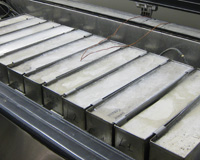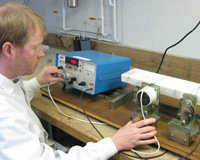


Freeze-thaw testing of architectural cast stone beams. The automated chamber is digitally controlled and measures the internal temperature of a control sample to cycle the test specimens above and below the freezing point. For cast stone, ASTM C 1364 provides pass/fail criteria based on cumulative weight loss. Other performance criteria may be specified by the client.
A technician measures the fundamental frequency of a marble panel during a scheduled stop in a freeze-thaw testing program. The frequency is used to calculate the elastic modulus of the stone. Reductions in the sample stiffness are an indication of incipient grain boundary failures. These tests may be performed nondestructively during the course of the freeze-thaw test. Once the freeze-thaw test is complete, comparisons can be made with more destructive tests such as flexural strength.
Freeze-Thaw Testing
Petrographic observations allow for predictive statements regarding the durability of materials subjected to severe climates. Both qualitative observations of microscopic pore structure and distribution as well as quantitative air-void analysis through statistical point-counting may be useful. However, it is sometimes desirable to perform an accelerated aging program to observe the performance of saturated materials during freeze-thaw cycling. ASTM specifies methods for both concrete and architectural cast stone and provides pass-fail performance criteria (ASTM C 666 and C 1354).

